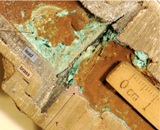

Utility 2 -More hydrated forms of copper sulfate also occur such as langite,
Cu4(SO4)(OH)6_2H2O .
Utility 15 -The most common green mineral in corrosion scales on copper is the copper carbonate, malachite:
Cu2(OH)2CO3








Examples of corrosion scales on brass pipes and fittings
| Utility 1 - connection between brass and Pb pipe segments shows severe corrosion, indicating a galvanic enhancement of dissolution. The Pb is inducing dissolution in the brass from which Zn dissolves completely, whereas Cu reprecipitates at the junction as Cu sulfate or carbonate. Any Pb in the brass can be released to the water as particulates. |  |
||
| Utility 2 -Many copper minerals are green. One of the more common green scale minerals on brass is brochantite, Cu4(SO4)(OH)6 . |  |
||
Utility 2 -More hydrated forms of copper sulfate also occur such as langite, Cu4(SO4)(OH)6_2H2O . |
|
||
Utility 15 -The most common green mineral in corrosion scales on copper is the copper carbonate, malachite: Cu2(OH)2CO3 |
 |
 |
|
| Utility 2 - Copper oxides can have CuI or CuII valence states. The cupric variety CuO.forms the mineral tenorite, usually black in color, and most often found in hot water pipes, commonly associated with calcite (CaCO3) |  |
|
|
| Utility 15- The cuprous oxide cuprite, Cu2O, is more common as a scale on cold water copper pipes, associated with malachite. |  |
 |
|
| Utility 6 - Mn oxide scale on brass pipe. The texture is characteristic of bacterially-precipitated Mn. |  |
|
|
| Utility 11 - Scale on brass connection to Pb pipe made up of Al hydroxide with a thin coating of Fe hydroxide. |  |
 |
|
| Utility 11 - Closer view of scale showing the uppermost Fe layer, followed by Al, underlain by greenish Cu carbonate. | |||